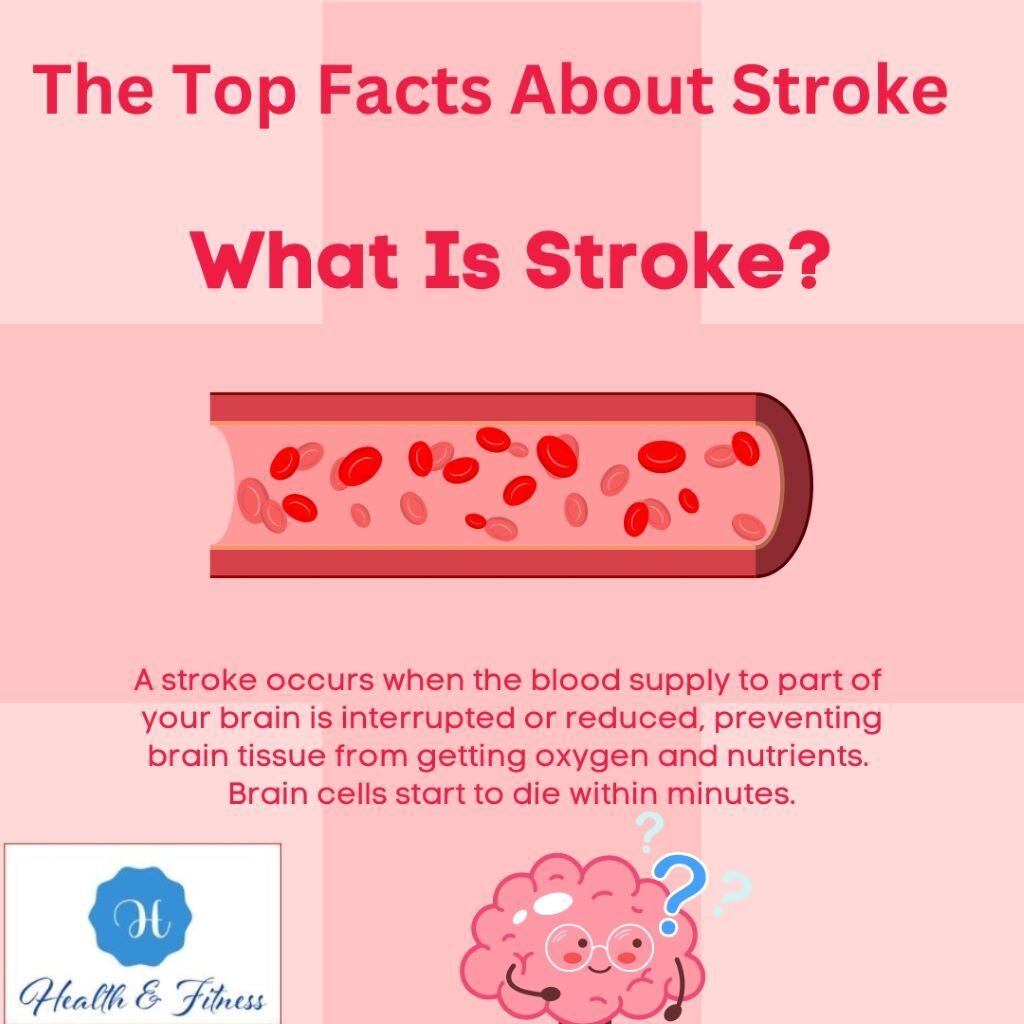The Top Facts You Should Know About Stroke: Ultimate Guide
Discover essential stroke facts in this ultimate guide. Learn about warning signs, risk factors, prevention strategies, and life after a stroke to stay informed and protect your health.
Introduction
Welcome to our extensive guide on stroke facts – a critical medical condition that demands attention and understanding. A stroke, often referred to as a “brain attack,” occurs when there is a sudden disruption in the blood supply to the brain, leading to the deprivation of essential oxygen and nutrients. This interruption can occur because of either a blocked blood vessel (ischemic ) or a burst blood vessel (hemorrhagic ). Equipping yourself with knowledge about brain attack facts is crucial as it can help you identify warning signs, reduce risk factors, and save lives. In this article, we will delve into the top 25 facts about Apoplexy that everyone should be aware of!
Top 25 stroke facts
Discover the top 25 Brain attack facts you need to know! Learn about warning signs, risk factors, prevention strategies, and life after it. Stay informed and protect yourself and your loved ones from this serious medical condition. Empower yourself with knowledge for a healthier future.
Stroke Strikes Without Warning
One of the most startling Apoplexy facts is that it often strikes without any prior warning signs. Unlike many other medical conditions, it can happen suddenly and unexpectedly. It can affect anyone, regardless of age, gender, or ethnicity. This unpredictability emphasizes the importance of understanding the risk factors and making necessary lifestyle changes to minimize the chances of suffering from a brain attack.
Know the Warning Signs
While stroke can be sneaky, it does exhibit warning signs that you must recognize to act swiftly. The most common symptoms of it can be remembered using the acronym FAST:
- Face drooping: Sudden numbness or weakness in the face, especially on one side.
- Arm weakness: Inability to lift both arms evenly or experiencing weakness in one arm.
- Speech difficulty: Difficulty in speaking or slurred speech.
- Time to call emergency services: If you or someone else is experiencing any of these symptoms, call emergency services immediately.
Recognizing the warning signs and seeking prompt medical attention can significantly improve the chances of minimizing damage and enhancing the recovery process.
Time is of the Essence
Time is critical for dealing with a stroke. Medical professionals emphasize the golden rule: “Time lost is brain lost.” The longer the brain is deprived of oxygen and nutrients, the more extensive the damage can be. If you suspect someone is having it or experiencing any of the warning signs, act FAST and call emergency services without delay.
Every Second Count
Building upon the previous point, let’s emphasize that every second counts during an Apoplexy. On average, a person loses around 1.9 million brain cells per minute during a stroke. This sobering fact underscores the urgency of seeking immediate medical attention. Quick action can make a significant difference in the outcome and the level of disability post-brain attack.
Stroke is a Leading Cause of Disability
It can leave behind life-altering consequences for survivors. It is a leading cause of long-term disability worldwide, affecting the physical, cognitive, and emotional well-being of those affected. Post-brain attack rehabilitation and support are essential for helping survivors regain independence and improving their overall quality of life.
Different Types of Stroke
it facts reveal that there are two main types of Brain attack – ischemic and hemorrhagic.
- Ischemic Stroke: This is the most common type, accounting for about 80% of all Brain attacks. It occurs when a blood clot (thrombus) forms within a blood vessel in the brain, obstructing blood flow.
- Hemorrhagic Stroke: This type of brain attack occurs when a blood vessel in the brain ruptures, leading to bleeding in or around the brain.
Understanding the type of Ischemic Stroke is crucial for appropriate treatment and management.
Women and Stroke
It is not just a male concern; it affects women significantly as well. Seizure kills more women than breast cancer each year. Women also have unique Seizure risk factors, including pregnancy-related complications and hormonal changes. Women need to be proactive in managing these risk factors and adopting a heart-healthy lifestyle.
Age and Stroke Risk
Age plays a significant role in seizure risk. While it can happen at any age, the likelihood increases with advancing age. Older individuals need to be vigilant in managing risk factors and making healthy choices to reduce the chance of experiencing an infarction.
High Blood Pressure – A Major Culprit
High blood pressure, also known as hypertension, is a major risk factor for stroke. Uncontrolled high blood pressure weakens blood vessels and increases the chances of an Apoplexy occurring. Regular check-ups and lifestyle modifications, such as a low-sodium diet and exercise, can help manage blood pressure effectively.
Lifestyle Choices Matter
Your lifestyle choices can significantly impact your stroke risk. Smoking, excessive alcohol consumption, a sedentary lifestyle, and an unhealthy diet are all contributing factors to Apoplexy risk. Opting for a balanced diet rich in fruits, vegetables, and whole grains, engaging in regular physical activity, and avoiding harmful habits can significantly reduce the risk of brain attack.
Diabetes and Stroke Risk
People with diabetes are at a higher risk of suffering from an Apoplexy. Diabetes affects blood vessels and can lead to the development of other risk factors, such as high blood pressure and high cholesterol. Proper diabetes management, including monitoring blood sugar levels and following a recommended treatment plan, is crucial to minimize brain attack risk.
Know Your Family History
Your family’s medical history can provide valuable insights into your brain attack risk. If you have a family history of stroke or related conditions, such as heart disease, it’s essential to inform your healthcare provider. They can help you take necessary precautions, conduct relevant screenings, and monitor your health more closely.
The Role of Cholesterol
High cholesterol levels can contribute to the formation of plaque in blood vessels, increasing the risk of stroke. Monitoring cholesterol levels and making dietary adjustments, such as reducing saturated and trans fats, can help manage this risk factor.
Stay Hydrated, Stay Protected
Dehydration can raise the risk of stroke, so staying well-hydrated is crucial. Ensure to drink plenty of water throughout the day and avoid excessive consumption of dehydrating beverages, such as alcohol and caffeine.
Take Care of Your Heart
A healthy heart is essential for stroke prevention. Regular cardiovascular check-ups, managing heart conditions, and adhering to prescribed medications can significantly reduce the likelihood of suffering from Brain attack
Post-Stroke Rehabilitation
Recovery doesn’t end with survival. Post-brain attack rehabilitation plays a vital role in improving the quality of life for Brain attack survivors. It involves various therapies, such as physical therapy, occupational therapy, and speech therapy, to regain physical and cognitive functions. Emotional support from family, friends, and healthcare professionals is equally essential during this process.
The Impact on Mental Health
It affects not only the body but also the mind. Survivors may experience anxiety, depression, and emotional changes as they adapt to life after a stroke. Seeking professional help and having a strong support system are essential for addressing these challenges and promoting mental well-being.
Empower Yourself with Knowledge
Knowledge is power for stroke prevention. Staying informed about the risk factors, warning signs and lifestyle changes that can reduce your chances of experiencing a Brain attack is crucial. Share this knowledge with your loved ones to create a stroke-aware community to support and protect each other.
Stroke Can Happen at Any Time
Contrary to common misconceptions, brain attack is not solely an “old-age” ailment. While age is indeed a risk factor, It can happen at any stage of life, including in children and young adults. Recognizing this fact emphasizes the importance of adopting a healthy lifestyle and managing risk factors from an early age.
Transient Ischemic Attack (TIA) – The Warning Stroke
A Transient Ischemic Attack, or TIA, is often referred to as a “mini-convulsion” or a “warning brain attack.” It is caused by a temporary blockage in the blood vessels, leading to brain attack-like symptoms that last for a stint (typically less than an hour). While TIAs may not cause permanent damage, they are a warning sign that a full-blown Apoplexy could occur in the future. Recognizing and treating TIAs promptly can prevent a more severe Apoplexy from happening.
Ethnicity and Stroke Risk
It risk can vary among different ethnic groups. Some ethnicities, such as African Americans, Hispanics, and South Asians, may have a higher risk of it compared to others. Understanding this variation can help healthcare providers tailor preventive strategies and interventions for specific populations.
Secondary Prevention After Stroke
If someone has already experienced a brain attack, secondary prevention becomes crucial to prevent a recurrence. This involves managing risk factors even more diligently, following prescribed medications, and making necessary lifestyle adjustments to minimize the chances of another brain attack.
Ischemic Strokes Can Be Treated with Clot-Busting Medication
With ischemic Apoplexy, clot-busting medications called thrombolytic can be administered to dissolve the blood clot and restore blood flow to the brain. However, these medications must be administered within a specific time window from the onset of symptoms to be effective.
Endovascular Treatment for Ischemic Strokes
In certain cases of ischemic Brain attack endovascular treatment, also known as mechanical thrombectomy, can be performed. This procedure involves removing the clot using a specialized device threaded through blood vessels, thus restoring blood flow.
Life After Stroke
Life after an Apoplexy can be challenging for both survivors and their caregivers. The road to recovery may be long and require ongoing support and adaptation. Post-stroke support groups, counselling, and resources are available to assist stroke survivors and their families in navigating this journey.
Frequently Asked Questions about Stroke Facts.
Q: Can strokes be prevented?
A: Absolutely! While some risk factors, such as age and family history, cannot be changed, there are many preventive measures you can take to reduce the likelihood of experiencing a brain attack. Adopting a heart-healthy lifestyle, including a balanced diet, regular exercise, and avoiding smoking and excessive alcohol consumption, can significantly lower your risk. Managing conditions like high blood pressure, diabetes, and cholesterol is crucial. Remember, knowledge and awareness are the first steps towards prevention.
Q: Can you have a stroke and not know it?
A: Yes, you can. These are known as silent brain attacks and often go unnoticed. They still damage brain cells, though, and can lead to future strokes.
Q: Can young people have a stroke?
A: Absolutely. While the risk increases with age, brain attacks can and do occur at any age.
Q: How can I reduce my risk of having a stroke?
A: The best way to reduce risk is by controlling the various risk factors. This includes maintaining a healthy diet, exercising regularly, quitting smoking, and regularly checking your blood pressure.
Q: Can you completely recover from a stroke?
A: Recovery varies greatly from person to person. Some people recover fully, while others may have long-term or severe disabilities.
Q: What is the difference between a stroke and a heart attack?
A: A stroke occurs when blood flow to a part of the brain is cut off, while a heart attack happens when blood flow to a part of the heart is blocked.
Conclusion
strokes are a significant health issue, but there’s a lot we can do to prevent them and improve recovery when they happen. The more we know about these stroke facts, the better our chances of reducing the impact of this disease. Stay informed, stay healthy, and remember: acting FAST can make all the difference.
Reference
https://www.ahajournals.org/doi/full/10.1161/01.str.0000442009.06663.48



